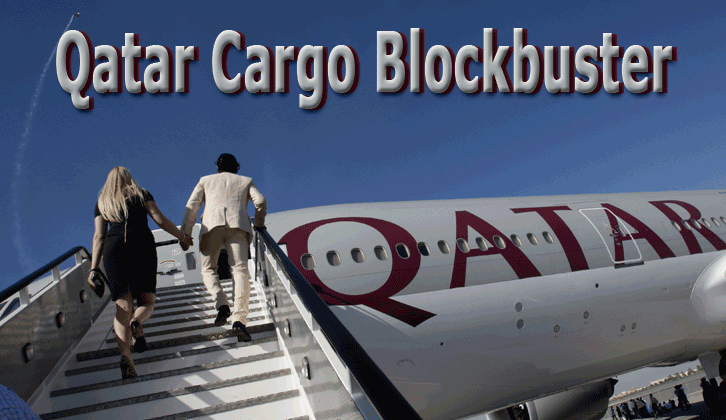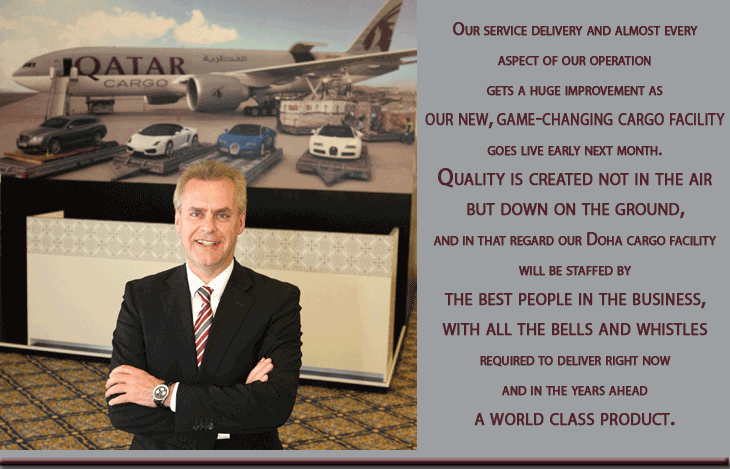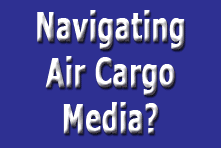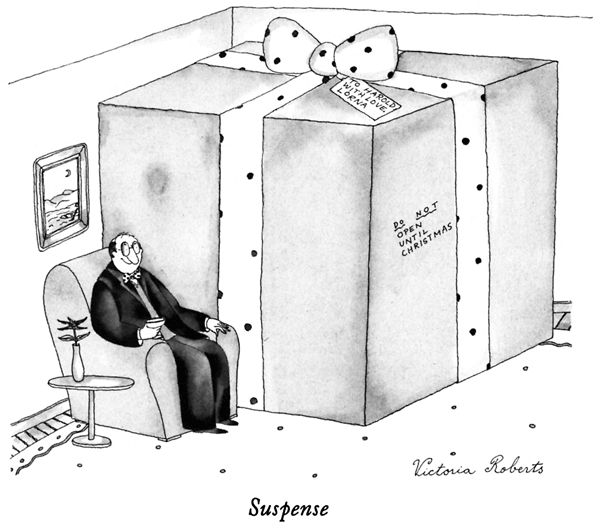
 March
18, 2013 March
18, 2013
(Dateline Doha)—The
IATA WCS 2013 show is in town. Inside the big hotel with the sloping sides
and midway down a long, thin, window-walled hallway, Uli Ogiermann sits
in a comfortable room set up for interviews.
It has only been five months since Uli took
up the reigns as Chief Cargo Officer at Qatar Airways, but he is no stranger
to handling hot potatoes and describes his current position as “the
opportunity of a lifetime.”
Outside in a dozen meeting rooms the global
business of air cargo is deconstructed and discussed, as Doha is magnet
once again for another important international conference.
Just down the road, a grand new terminal
complex will open to support Qatar Cargo as the airport is rebuilt to
serve this booming and growing Middle East Metropolis early next month.
Significantly, the cargo build debuts before
the rest of the new, billion-dollar international airport is revealed,
which will happen in stages throughout the remainder of 2013.
The next big story in air cargo is actually
happening right now, with the emergence of Qatar Airways on the world
scene; the change will reverberate around the world.
 |

From the get-go, the placement of Mr. Ogiermann
has brought to Doha a proven air cargo executive, with leadership and
performance credentials second to none.
As CEO of Cargolux and Chairman of The International
Air Cargo Association, Uli has weathered every storm and has stood up
and done the right thing for the air cargo industry.
As good and decent an individual as you
might ever know, Uli appears energized, healthy, and absolutely thrilled
to be on top of things.

As World Cargo Symposium began in Doha,
Akbar Al Baker, CEO of Qatar Airways as usual made headlines all over
the world painting the canvas in a word picture of bold and clear colors
that will be recalled as “Five By Five”:
“Our vision is clear,” Mr. Al
Baker said.
“We know where we are heading—ultimately,
to be among the top five air cargo operators in the world within five
years.
“And when I say number five, that
is just what the planning people suggest.
“I would prefer to shorten the number
to second or third place.”
A quick look at IATA tonnage figures underscore
the dramatic shift underway as FedEx tops the list as usual, but number
two is expected to be Emirates, which bumps Korean from a perch it has
held for some years.
If Mr. Al Baker’s prediction is correct,
by 2018 two of the top five air cargo carriers in the world could be operating
from hubs less than 30 minutes apart by air.
“Qatar Airways Cargo is increasing
by 20 percent a year, so with the opening of our new cargo airport in
April we expect a huge increase,” Mr. Al Baker said.

“This year of 2013 is a real game
changer with a new cargo facility, new people in a recently formed team,
which also takes a gigantic step in terms of capacity, putting this airline
into a different league.”
“In terms of capacity Qatar Airways
Cargo will grow by close to 40% in 2013.
“We are adding 3 A330Fs (replacing
3 A300Fs) that can lift 70 tons versus 50 on A300.
“Qatar Cargo also takes delivery of
a B777F this summer, and adds an additional 3 A330Fs by end of this year.
“So in total 7 new freighters are
being delivered in 2013 with net effect of four, as A300s are phased out.
“Looking even further ahead in the
following years, this steep jump in capacity might not be repeated, but
we will continue to add at least 20 % every year.”
In January Qatar Airways introduced its
latest gateway in the Republic of Iraq, adding scheduled flights to the
central city of Najaf, which followed the move into that country in mid
2012 with flights to both the capital of Baghdad, and Erbil.
On the back of passenger demand to Iraq,
Qatar Airways said that it viewed expansion into Iraq as “being
vital, fuelled by the country’s reconstruction drive.”
Qatar Airways currently operates 122 aircraft
to 125 cities across Europe, Middle East, Africa, Asia Pacific, and The
Americas. Qatar Airways 2013 new service was launched to Phnom Penh, Cambodia
on February 20 and the next big launch is to Chicago on April 10.

“But speaking about WCS here in Doha
this week,” Uli said, “It is a great honor to host that event.”
“WCS’s location also acknowledges
the activities that have been ongoing in Qatar air cargo development,
as this gateway emerges among the most important current and future global
destinations.
“The government here has endorsed
and supports aviation, and it shows.
“The new international airport opening
in Doha toward the end of 2013 at a cost of $15 billion will be world
class and, in many ways, world beating.
“Prior to that opening we have a $1
billion new cargo terminal debuting here on April 8 that will include
55,000 square meters.”

As mentioned, Uli Ogermann has handled critical
air cargo posts in a long and distinguished career of service to the industry.
But he indicates the QR posting is different.
“The thing that impresses me here
in Doha and throughout Qatar is the openness of the people and especially
the airline company.
“Qatar Airways is like a mini United
Nations, staffed with people from dozens of nationalities.
“The result is an even richer overall
culture to everyday work that makes things quite a bit more exciting,
varied, and rewarding, and a constant learning and doing process.
“There is a positive spirit about
things here that is in marked contrast to working in other parts of the
world.”
“Folks in these parts see the opportunity
to build something, to make a better life by creating something new and
wonderful, and everybody is energized by the experience.”
“It’s a huge challenge, but
for myself and many others, it is also a once in a lifetime opportunity.
“The drivers here are capital for
investments, close accountability, a baseline demand toward excellence,
and many other factors; they give Qatar a special edge.

“We have indeed given the CEO a scenario:
we want to be amongst the top five cargo operators worldwide within the
next five years.
“Of course, Mr. Al Baker noted in
his opening speech at WCS that our goal lifted the bar, saying: ‘Of
course the number 5 is what they said, but you know me, I want our cargo
business worldwide to rank second or third in that time span.’
“We will have to make that work,”
Uli smiled.
“Our service delivery and almost every
aspect of our operation gets a huge improvement as our new, game-changing
cargo facility goes live early next month.
“Quality is created not in the air
but down on the ground, and in that regard our Doha cargo facility will
be staffed by the best people in the business, with all the bells and
whistles required to deliver a world class product right now and in the
years ahead.”
In 2013 Qatar Airways celebrates 16 years
since Akbar Al Baker came on board as CEO and changed the airline forever.
If “Sweet Sixteen” is the charm,
this is one airline that will not be denied a great future that aims for
nothing less than the very top of the heap.
There was a coming out party last week in
Doha and everybody in the global village of air cargo management saw the
city, the airline, and the air cargo future.
With Uli at the controls there is only one
way to describe the action in Doha:
Qatar Cargo looks “Unbeatable.”
Geoffrey/Flossie
|







